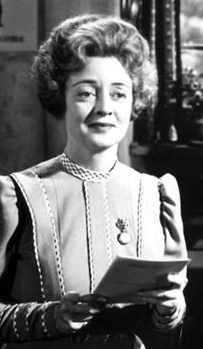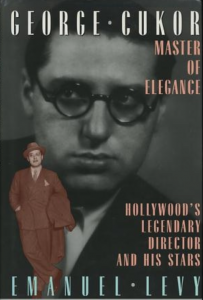Irving Rapper’s screen version of Emlyn Williams’ semi-autobiographical play of 1938, The Corn is Green, is one of his best works.
Grade: B (*** out of *****)
| The Corn Is Green | |
|---|---|

Theatrical release poster
|
|
It also represents one of his several collaborations with star Bette Davis, the best of which is the 1942 Now Voyager.
In this theatrical rendition, shot on Warner’s sound stages, Davis reprises the role that was famously originated on the London stage by Dame Sybil Thorndike and on Broadway by Ethel Barrymore. In another words, it’s a great role for a grand actress.
Since the character was supposed to be in her 50s, Bette Davis, then 36, wore a gray wig and a “fat suit” that added 30 pounds.
Richard Waring was originally cast for the part of Morgan, but was drafted for World War II.
Rhys Williams, Rosalind Ivan, Mildred Dunnock and Gene Moss, members of the Broadway cast, reprised their roles for this film.
Davis plays Miss Moffatt, a turn-of-the-century aging spinster, who arrives as a schoolteacher in a Welsh mining town. She opens her own school in hopes of lowering the town’s illiteracy rate, thus enabling the younger residents to seek out more fulfilling lives than merely working in the mines (where most of their parents are employed).
It’s an uphill battle for Miss Moffatt, to say the least. Initially, she runs into resistance from mine-owner Nigel Bruce, who realizes that as soon as the citizens can read and write, they’ll rebel against his rule.
Miss Moffatt herself is full of doubts about her idealistic mission—that is, until she meets a young miner (played by John Dall in his film debut), who wants to know “what is behind all those books.” Within two years, Dall makes so much progress that he is qualified for admission in Oxford.
In an unconvincing subplot, Dall gets romantically involved with (Joan Lorring, Oscar nominated), who threatens to derail Moffat’s plan.
A last-minute obstacle involving Dall’s illegitimate child is resolved, when Miss Moffatt herself agrees to adopt the baby so that her student can complete his education.
This was a personal work for the playwright: Emlyn Williams himself came from a backward mining town, and was inspired to a better life by a compassionate schoolteacher.
My biography of George Cukor
“The Corn is Green” was remade for television by George Cukor in 1978, with Katharine Hepburn as Miss Moffatt. But flawed (too conventional and sentimental) as the Davis version is, it’s still superior to Cukor’s version. At 71, Hepburn was too old for the part.
The 1945 version was popular at the box-office, both domestically and internationally.
Oscar Nominations: 2
Supporting Actor: John Dall
Supporting Actress: Joan Lorring
Oscar Awards: None
Oscar Context:
“The Lost Weekend” won over Hitchcock’s suspense-thriller “Spellbound” and Leo McCarey’s comedy “The Bells of St. Mary’s,” both starring Ingrid Bergman. The other two nominees were the MGM musical “Anchors Aweigh” and Warner’s noir melodrama “Mildred Pierce,” for which Joan Crawford won the Best Actress for a comeback performance. The most nominated film was “The Bells of St. Mary’s” (8), though it won only one award, for Stephen Dunn’s Sound Recording, perhaps because it was a sequel to “Going My Way,” which swept most of the 1944 Oscars.
In 1945, the winners of the Supporting Acting Oscars were James Dunn in Kazan’s family melodrama, “A Tree Grows in Brooklyn,” and Anne revere as the young Elizabeth Taylor’s mother in “National Velvet.”
John Dall’s most famous role is arguably that of the arrogant murderer in Hitchcock’s thriller “Rope” (1950); he also had a small part in “Spartacus.”
About Irving Rapper
Irving Rapper joined the Washington Square Players as a stage director while studying at NYU University. He later appeared and directed on Broadway and arrived in Hollywood in the mid-30s as an assistant director and dialogue coach. He worked in such capacities on such Warner films as The Story of Louis Pasteur (1935), The Life of Emile Zola (1937), Four Daughters (1938), Juarez (1939), and Dr. Ehrlich’s Magic Bullet (1940) before making his debut as a full director in 1941.
Though his film work tends to betray his theatrical background and is often stagy and talky, he was occasionally able to overcome this limitation with a flair for developing dramatic plots and directing actors. ”Now Voyager” (1942) is a superior melodrama, a weepie soap opera, beautifully played by Bette Davis and Claude Rains.
Most of his output after the late 1940s, when he left Warner’s, was uninspired.
Credits:
Directed by Irving Rapper
Written by Frank Cavett, Casey Robinson, based on The Corn Is Green 1938 play by Emlyn Williams
Produced by Jack Chertok
Cinematography Sol Polito
Edited by Frederick Richards
Music by Max Steiner
Distributed by Warner Bros.
Release date: July 14, 1945
Running time: 115 minutes
Budget $1,545,000
Box office $3,649,000
Cast:
Bette Davis as Lily Cristobel Moffatt
Nigel Bruce as the Squire
John Dall as Morgan Evans.
Rhys Williams as Mr. Jones
Rosalind Ivan as Mrs. Watty
Mildred Dunnock as Miss Ronberry
Arthur Shields as Glyn Thomas
Gwyneth Hughes as Sarah Pugh
Thomas Louden as Old Tom
Rhoda Williams As Wylodine
Joan Lorring as Bessie Watty













